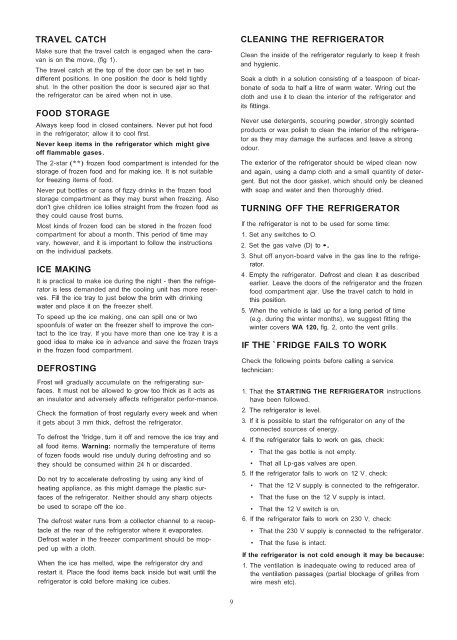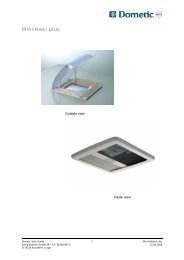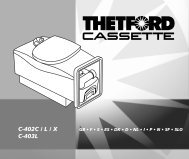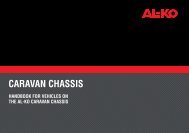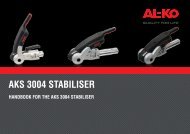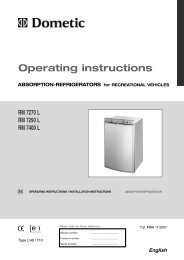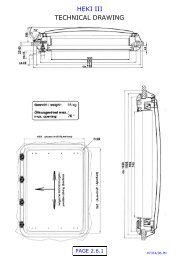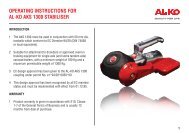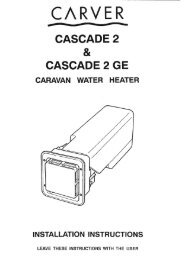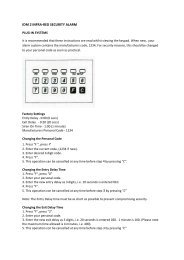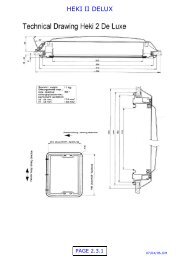RM4270 & RM4271 fridge manual - Swift Owners Club
RM4270 & RM4271 fridge manual - Swift Owners Club
RM4270 & RM4271 fridge manual - Swift Owners Club
Create successful ePaper yourself
Turn your PDF publications into a flip-book with our unique Google optimized e-Paper software.
TRAVEL CATCH<br />
Make sure that the travel catch is engaged when the caravan<br />
is on the move, (fig 1).<br />
The travel catch at the top of the door can be set in two<br />
different positions. In one position the door is held tightly<br />
shut. In the other position the door is secured ajar so that<br />
the refrigerator can be aired when not in use.<br />
FOOD STORAGE<br />
Always keep food in closed containers. Never put hot food<br />
in the refrigerator; allow it to cool first.<br />
Never keep items in the refrigerator which might give<br />
off flammable gases.<br />
The 2-star (**) frozen food compartment is intended for the<br />
storage of frozen food and for making ice. It is not suitable<br />
for freezing items of food.<br />
Never put bottles or cans of fizzy drinks in the frozen food<br />
storage compartment as they may burst when freezing. Also<br />
don't give children ice lollies straight from the frozen food as<br />
they could cause frost burns.<br />
Most kinds of frozen food can be stored in the frozen food<br />
compartment for about a month. This period of time may<br />
vary, however, and it is important to follow the instructions<br />
on the individual packets.<br />
ICE MAKING<br />
It is practical to make ice during the night - then the refrigerator<br />
is less demanded and the cooling unit has more reserves.<br />
Fill the ice tray to just below the brim with drinking<br />
water and place it on the freezer shelf.<br />
To speed up the ice making, one can spill one or two<br />
spoonfuls of water on the freezer shelf to improve the contact<br />
to the ice tray. If you have more than one ice tray it is a<br />
good idea to make ice in advance and save the frozen trays<br />
in the frozen food compartment.<br />
DEFROSTING<br />
Frost will gradually accumulate on the refrigerating surfaces.<br />
It must not be allowed to grow too thick as it acts as<br />
an insulator and adversely affects refrigerator perfor-mance.<br />
Check the formation of frost regularly every week and when<br />
it gets about 3 mm thick, defrost the refrigerator.<br />
To defrost the '<strong>fridge</strong> , turn it off and remove the ice tray and<br />
all food items. Warning: normally the temperature of items<br />
of fozen foods would rise unduly during defrosting and so<br />
they should be consumed within 24 h or discarded.<br />
Do not try to accelerate defrosting by using any kind of<br />
heating appliance, as this might damage the plastic surfaces<br />
of the refrigerator. Neither should any sharp objects<br />
be used to scrape off the ice.<br />
The defrost water runs from a collector channel to a receptacle<br />
at the rear of the refrigerator where it evaporates.<br />
Defrost water in the freezer compartment should be mopped<br />
up with a cloth.<br />
When the ice has melted, wipe the refrigerator dry and<br />
restart it. Place the food items back inside but wait until the<br />
refrigerator is cold before making ice cubes.<br />
CLEANING THE REFRIGERATOR<br />
Clean the inside of the refrigerator regularly to keep it fresh<br />
and hygienic.<br />
Soak a cloth in a solution consisting of a teaspoon of bicarbonate<br />
of soda to half a litre of warm water. Wring out the<br />
cloth and use it to clean the interior of the refrigerator and<br />
its fittings.<br />
Never use detergents, scouring powder, strongly scented<br />
products or wax polish to clean the interior of the refrigerator<br />
as they may damage the surfaces and leave a strong<br />
odour.<br />
The exterior of the refrigerator should be wiped clean now<br />
and again, using a damp cloth and a small quantity of detergent.<br />
But not the door gasket, which should only be cleaned<br />
with soap and water and then thoroughly dried.<br />
TURNING OFF THE REFRIGERATOR<br />
If the refrigerator is not to be used for some time:<br />
1. Set any switches to O.<br />
2. Set the gas valve (D) to •.<br />
3. Shut off anyon-board valve in the gas line to the refrigerator.<br />
4. Empty the refrigerator. Defrost and clean it as described<br />
earlier. Leave the doors of the refrigerator and the frozen<br />
food compartment ajar. Use the travel catch to hold in<br />
this position.<br />
5. When the vehicle is laid up for a long period of time<br />
(e.g . during the winter months), we suggest fitting the<br />
winter covers WA 120, fig. 2, onto the vent grills.<br />
IF<br />
FRIDGE FAILS TO WORK<br />
Check the following points before calling a service<br />
technician:<br />
1. That the STARTING THE REFRIGERATOR instructions<br />
have been followed.<br />
2. The refrigerator is level.<br />
3. If it is possible to start the refrigerator on any of the<br />
connected sources of energy.<br />
4. If the refrigerator fails to work on gas, check:<br />
• That the gas bottle is not empty.<br />
• That all Lp-gas valves are open.<br />
5. If the refrigerator fails to work on 12 V, check:<br />
• That the 12 V supply is connected to the refrigerator.<br />
• That the fuse on the 12 V supply is intact.<br />
• That the 12 V switch is on.<br />
6. If the refrigerator fails to work on 230 V, check:<br />
• That the 230 V supply is connected to the refrigerator.<br />
• That the fuse is intact.<br />
If the refrigerator is not cold enough it may be because:<br />
1. The ventilation is inadequate owing to reduced area of<br />
the ventilation passages (partial blockage of grilles from<br />
wire mesh etc).<br />
9


